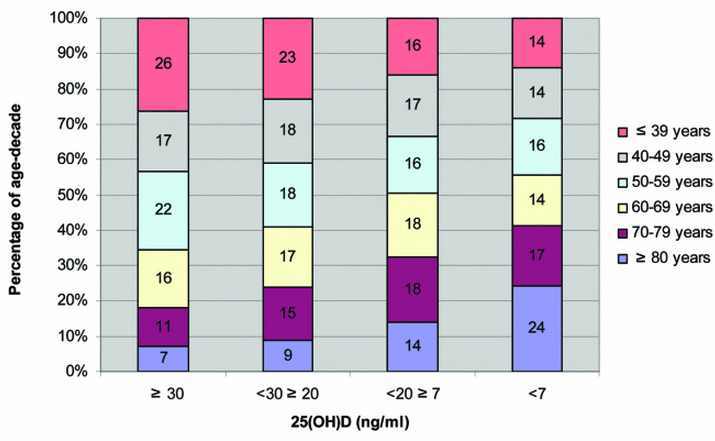83 year-old women in Europe have 11 ng of vitamin D
Prevalence of vitamin D inadequacy in European women aged over 80 years
Archives of Gerontology and Geriatrics; Volume 59, Issue 1, July–August 2014, Pages 78–82
Olivier Bruyèrea, [email protected], Justine Slomiana, Charlotte Beaudarta, Fanny Buckinxa, Etienne Cavalierb, Sophie Gillainc, Jean Petermansc, Jean-Yves Reginstera
Highlights
• A high prevalence of vitamin D inadequacy is observed in old European women.
• There is a highly significant difference in vitamin D level across European countries.
• Age, BMI, country and vitamin D supplementation are associated with vitamin D level.
Inadequate vitamin D status is associated with secondary hyperparathyroidism and increased bone turnover and bone loss, which in turn increases fracture risk. The objective of this study is to assess the prevalence of inadequate vitamin D status in European women aged over 80 years.
Assessments of serum 25-hydroxyvitamin D levels (25(OH)D) were performed on 8532 European women with osteoporosis or osteopenia of which 1984 were aged over 80 years. European countries included in the study were: France, Belgium, Denmark, Italy, Poland, Hungary, United Kingdom, Spain and Germany . Two cut-offs of 25(OH)D inadequacy were fixed: <75 nmol/L (30 ng/ml) and <50 nmol/L (20 ng/ml).
Mean (SD) age of the patients was 83.4 (2.9) years, body mass index was 25.0 (4.0) kg/m2 and level of 25(OH)D was 53.3 (26.7) nmol/L (21.4 [10.7] ng/ml). There was a highly significant difference of 25(OH)D level across European countries (p < 0.0001). In these women aged over 80 years, the prevalence of 25(OH)D inadequacy was 80.9% and 44.5% when considering cut-offs of 75 and 50 nmol/L, respectively. In the 397 (20.0%) patients taking supplemental vitamin D with or without supplemental calcium, the mean serum 25(OH)D level was significantly higher than in the other patients (65.2 (29.2) nmol/L vs. 50.3 (25.2) nmol/L; P < 0.001).
This study indicates a high prevalence of vitamin D (25(OH)D) inadequacy in old European women. The prevalence could be even higher in some particular countries.
81% < 30 ng/ml – includes the 20% were taking (a small amount of) vitmain D supplements
See also Vitamin D Life
Incidence of 22 health problems related to vitamin D have doubled in a decade
Summary review of Vitamin D for Europe is behind a paywall – Aug 2013
German seniors 10 pct less than 7ng, 92 pct less than 30 ng vitamin D – Jan 2012
Vitamin D levels in Germany – Jan 2012 has the following chart

13 reasons why many seniors need more vitamin D (both dose and level) - July 2023 has the following
{include}
